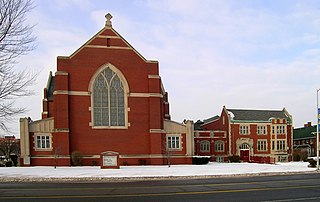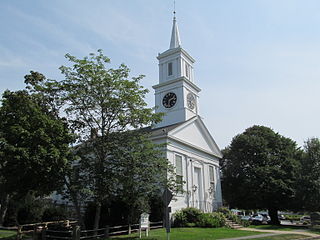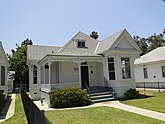
Broadway, until 1890 Fort Street, is a thoroughfare in Los Angeles County, California, United States. The portion of Broadway from 3rd to 9th streets, in the Historic Core of Downtown Los Angeles, was the city's main commercial street from the 1910s until World War II, and is the location of the Broadway Theater and Commercial District, the first and largest historic theater district listed on the National Register of Historic Places (NRHP). With twelve movie palaces located along a six-block stretch of Broadway, it is the only large concentration of movie palaces left in the United States.

Wilshire Center is a neighborhood in the Wilshire region of Los Angeles, California.

Sidney Rose Badgley was a prominent start-of-the-20th-century Canadian-born architect. He was active throughout the United States and Canada, with a significant body of work in Cleveland.

The St. John's Christian Methodist Episcopal Church is a church located in Detroit, Michigan. It was built as the North Woodward Congregational Church, listed on the National Register of Historic Places in 1982, and designated a Michigan State Historic Site in 1998.

The Religious Structures of Woodward Avenue Thematic Resource (TR) is a multiple property submission to the National Register of Historic Places which was approved on August 3, 1982. The structures are located on Woodward Avenue in the cities of Detroit and Highland Park, Michigan.

The Centerville Historic District is a historic district encompassing the heart of the village of Centerville in Barnstable, Massachusetts. The district extends along Main Street from a point north of its junction with Old Stage Road and Park Avenue, south to the junction with Church Hill Road. Most of the buildings in the district were built in the middle decades of the 19th century, although its oldest building, the Austin Bearse House, was built c. 1690. The area's growth was spurred by the relocation in 1826 of the Congregational Church building to its present location. The district was listed on the National Register of Historic Places in 1987.

The First Congregational Church of East Hartford and Parsonage is a historic church at 829-837 Main Street in East Hartford, Connecticut. The congregation was founded around 1699 and the current church building was constructed around 1833. The building was added to the National Register of Historic Places in 1982. The congregation is currently affiliated with the United Church of Christ.

La Iglesia Pentecostal La Luz del Mundo / Light of the World Church Pentecostal Church is an Assemblies of God Pentecostal church in Williamsburg, Brooklyn, New York City, located at 179 South 9th Street, occupying the historic 19th-century former New England Congregational Church since 1955.

The Prince Hall Masonic Temple in South Los Angeles area of Los Angeles, California is a historic club building associated with Prince Hall Freemasonry. It was listed on the National Register of Historic Places in 2009. The structure, built in 1926, is a two-story masonry building which has been described as "very simple in design and almost appears to be commercial in use." The building was established as the Los Angeles branch of Prince Hall Freemasonry, a tradition of separate, predominantly African-American, Freemasonry in North America.

The Lincoln Theater is a historic theater in South Los Angeles, California. The Moorish Revival building was listed on the National Register of Historic Places in 2009. Sometimes referred to as the "West Coast Apollo", the Lincoln Theater was one of the most significant establishments along the Central Avenue Corridor that became the cultural and business hub of the African American community in Los Angeles from the 1920s to the 1950s. For more than 30 years, the Lincoln featured live theater, musical acts, talent shows, vaudeville, and motion pictures, including live performances by the leading African-American performers of the era, including Lionel Hampton, Duke Ellington, the Nat King Cole Trio, and Billie Holiday. The Lincoln Theater was managed and directed by Jules Wolf The theater was converted to use as a church in 1962 and continues to be used for religious services.

Second Baptist Church is a historically African-American Baptist church located in South Los Angeles, California. The current Lombardy Romanesque Revival building was built in 1926 and has been listed as a Los Angeles Historic-Cultural Monument (1978) and on the National Register of Historic Places (2009). The church has been an important force in the Civil Rights Movement, hosting national conventions of the National Association for the Advancement of Colored Persons ("NAACP") in 1928, 1942, and 1949, and also serving as the site of important speeches by Martin Luther King Jr., Malcolm X, and others. It is affiliated with the American Baptist Churches USA and the Progressive National Baptist Convention.

The 28th Street YMCA is a historic YMCA building in South Los Angeles, California. It was listed as a Los Angeles Historic-Cultural Monument in 2006 and put on the National Register of Historic Places in 2009. The four-story structure was built in 1926 at a cost of $200,000. The building was designed by noted African American architect Paul R. Williams in the Spanish Colonial Revival style.
Angelus Funeral Home is a funeral home at 1010 E Jefferson Blvd in South Los Angeles, California. It was listed as a Los Angeles Historic-Cultural Monument in 2006 and on the National Register of Historic Places in 2009. In 1925, Angelus Funeral Home was the first Black-owned business to be incorporated in California. The building was designed by noted African-American architect Paul R. Williams in the Spanish Colonial and Georgian Revival styles and also includes Art Deco elements.

The 52nd Place Historic District is a historic district consisting of American Craftsman style homes in the Central-Alameda neighborhood of the South Los Angeles, California. African Americans became the dominant demographic group in the district beginning around 1930 with important African-American people living here. The district includes 37 contributing buildings and seven non-contributing buildings. The contributing buildings are one-story Craftsman houses designed and built by Tifal Brothers between 1911 and 1914. The characteristic feature of the contributing buildings include "low-pitched gabled roofs with overhanging eaves and exposed rafter tails, front porches and chimneys made of brick or river rock, and multi-paned wood-framed casement windows." The district is located on 52nd Place between McKinley Avenue on the east and Avalon Boulevard on the west and lies just east of the South Park neighborhood.

Fire Station No. 14 is a historic fire station in the South Los Angeles region of Los Angeles, California. The three-story structure was designed by Earl T. Heitschmidt in the International style and was built in 1949.

Fire Station No. 30, Engine Company No. 30 is a historic fire station and engine company in the South Los Angeles area of Los Angeles, California.

The Chelsea Commercial Historic District is a historic district located along both sides of Main Street from Orchard to North Street in Chelsea, Michigan; the district also includes the adjacent 100 blocks of Jackson, East Middle, and West Middle Streets, as well as structures on Park, East, and Orchard Streets. It was listed on the National Register of Historic Places in 2011.

The Lincoln Park Historic District in Pomona, California is a 45-block, 230-acre residential neighborhood. The district consists of 821 structures—primarily single family homes built between the 1890s through the 1940s—featuring a wide variety of architectural styles from late Victorian and National Folk homes, Craftsman and Craftsman-influenced homes, as well as late 19th and 20th Century Revival architectural styles including Colonial, Mission/Spanish, Tudor and Classical Revival.

The Charlotte Central Historic District is a mixed commercial, residential, and historic district located in the downtown section of Charlotte, Michigan. The district stretches along Cochran Avenue from West McClure Street to south of Henry Street, containing portions of the streets adjacent to Cochran. It was listed on the National Register of Historic Places in 2020.



























